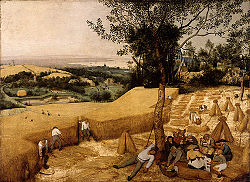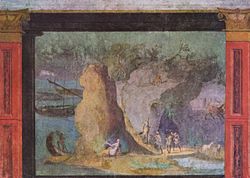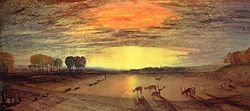
Shen Zhou, Poet on a Mountain c. 1500. Painting and poem by Shen Zhou:"White clouds encircle the mountain waist like a sash,/Stone steps mount high into the void where the narrow path leads far./Alone, leaning on my rustic staff I gaze idly into the distance./My longing for the notes of a flute is answered in the murmurings of the gorge."[2]

Pieter Brueghel the Elder, The Harvesters, 1565: Peace and agriculture in a pre-Romantic ideal landscape, without sublime terrors

Jan van Goyen, Dune landscape, c. 1630-1635, an example of the "tonal" style in Dutch Golden Age painting

Frederic Edwin Church, The Heart of the Andes, 1859. Church was part of the American Hudson River School.
The Chinese ink painting tradition of shan shui ("mountain-water"), or "pure" landscape, in which the only sign of human life is usually a sage, or a glimpse of his hut, arose in about the 8th century CE from increasingly sophisticated landscape backgrounds to figure subjects, and landscape art of this period retains a classic and much-imitated status within the Chinese tradition, although the actual date of surviving reputed 8th-century scroll-paintings is unclear.[5]
Both the Roman and Chinese traditions typically show grand panoramas of imaginary landscapes, generally backed with a range of spectacular mountains – in China often with waterfalls and in Rome often including sea, lakes or rivers. These were frequently used, as in the example illustrated, to bridge the gap between a foreground scene with figures and a distant panoramic vista, a persistent problem for landscape artists. The Chinese style generally showed only a distant view, or used dead ground or mist to avoid that difficulty.
A major contrast between landscape painting in the West and East Asia has been that while in the West until the 19th century it occupied a low position in the accepted hierarchy of genres, in East Asia the classic Chinese mountain-water ink painting was the most prestigous form of visual art. Aesthetic theories in both regions gave the highest status to the works seen to require the most imagination from the artist. In the West this was history painting, but in East Asia it was the imaginary landscape, whose most famous practitioners were, at least in theory, amateur literati, including several Emperors of both China and Japan. They were often also poets whose lines and images illustrated each other.[6] However in the West, history painting came to require an extensive landscape background where appropriate, so the theory did not entirely work against the development of landscape painting – for several centuries landscapes were regularly promoted to the status of history painting by the addition of small figures to make a narrative scene, typically religious or mythological.
[edit] Western tradition
In early Western medieval art interest in landscape disappears almost entirely, kept alive only in copies of Late Antique works such as the Utrecht Psalter; the last reworking of this source, in an early Gothic version, reduces the previously extensive landscapes to a few trees filling gaps in the composition, with no sense of overall space.[7] A revival in interest in nature initially mainly manifested itself in depictions of small gardens such as the Hortus Conclusus or those in millefleur tapestries. The frescos of figures at work or play in front of a background of dense trees in the Palace of the Popes, Avignon are probably a unique survival of what was a common subject.[8] Several frescos of gardens have survived from Roman houses like the Villa of Livia.[9]Early in the fifteenth century, landscape painting was established as a genre in Europe, as a setting for human activity, often expressed in a religious subject, such as the themes of the Rest on the Flight into Egypt, the Journey of the Magi, or Saint Jerome in the Desert. Luxury illuminated manuscripts were very important in the early development of landscape, especially series of the Labours of the Months such as those in the Très Riches Heures du Duc de Berry, which conventionally showed small genre figures in increasingly large landscape settings. A particular advance is shown in the less well-known Turin-Milan Hours, now largely destroyed by fire, whose developments were reflected in Early Netherlandish painting for the rest of the century. The artist known as "Hand G", probably one of the Van Eyck brothers, was especially successful in reproducing effects of light and in a natural-seeming progression from the foreground to the distant view.[10] This was something other artists were to find difficult for a century or more, often solving the problem by showing a landscape background from over the top of a parapet or window-sill, as if from a considerable height.[11]
Landscape backgrounds for various types of painting became increasingly prominent and skilful during the century. The period around the end of the 15th century saw pure landscape drawings and watercolours from Leonardo da Vinci, Albrecht Dürer, Fra Bartolomeo and others, but pure landscape subjects in painting and printmaking, still small, were first produced by Albrecht Altdorfer and others of the German Danube School in the early 16th century.[12] At the same time Joachim Patinir in the Netherlands developed a style of panoramic landscapes with a high aerial viewpoint that remained influential for a century, being used, for example, by Pieter Brueghel the Elder. The Italian development of a thorough system of graphical perspective was now known all over Europe, which allowed large and complex views to be painted very effectively.
Landscapes were idealized, mostly reflecting a pastoral ideal drawn from classical poetry which was first fully expressed by Giorgione and the young Titian, and remained associated above all with hilly wooded Italian landscape, which was depicted by artists from Northern Europe who had never visited Italy, just as plain-dwelling literati in China and Japan painted vertiginous mountains. Though often young artists were encouraged to visit Italy to experience Italian light, many Northern european artists could make their living selling Italianate landscapes without ever bothering to make the trip. Indeed, certain styles were so popular that they became formulas that could be copied again and again.
The popularity of exotic landscape scenes can be seen in the success of the painter Frans Post, who spent the rest of his life painting Brazilian landscapes after a trip there in 1636-1644. Other painters who never crossed the Alps could make money selling Rhineland landscapes, and still others for constructing fantasy scenes for a particular commission such as Cornelis de Man's view of Smeerenburg in 1639.
Compositional formulae using elements like the repoussoir were evolved which remain influential in modern photography and painting, notably by Poussin [13] and Claude Lorrain, both French artists living in 17th century Rome and painting largely classical subject-matter, or Biblical scenes set in the same landscapes. Unlike their Dutch contemporaries, Italian and French landscape artists still most often wanted to keep their classification within the hierarchy of genres as history painting by including small figures to represent a scene from classical mythology or the Bible. Salvator Rosa gave picturesque excitement to his landscapes by showing wilder Southern Italian country, often populated by banditi.[14]
The Dutch Golden Age painting of the 17th century saw the dramatic growth of landscape painting, in which many artists specialized, and the development of extremely subtle realist techniques for depicting light and weather. There are different styles and periods, and sub-genres of marine and animal painting, as well as a distinct style of Italianate landscape. Most Dutch landscapes were relatively small, but landscapes in Flemish Baroque painting, still usually peopled, were often very large, above all in the series of works that Peter Paul Rubens painted for his own houses.
Some Dutch landscape specialties named in period inventories include the Batalje, or battle-scene; the Maneschijntje, or moonlight scene; the Bosjes, or woodland scene; the Boederijtje, or farm scene, and the Dorpje or village scene. Though not named at the time as a specific genre, the popularity of Roman ruins inspired many Dutch landscape painters of the period to paint the ruins of their own region, such as monasteries and churches ruined after the Beeldenstorm. The popularity of landscapes in the Netherlands was in part a reflection of the virtual disappearance of religious painting in a Calvinist society, and the decline of religious painting in the 18th and 19th centuries all over Europe combined with Romanticism to give landscapes a much greater and more prestigous place in 19th-century art than they had assumed before.
In England, landscapes had initially been mostly backgrounds to portraits, typically suggesting the parks or estates of a landowner, though mostly painted in London by an artist who had never visited his sitter's rolling acres; the English tradition was founded by Anthony van Dyck and other mostly Flemish artists working in England. In the 18th century, watercolour painting, mostly of landscapes, became an English speciality, with both a buoyant market for professional works, and a large number of amateur painters, many following the popular systems found in the books of Alexander Cozens and others. By the beginning of the 19th century the English artists with the highest modern reputations were mostly dedicated landscapists, showing the wide range of Romantic interpretations of the English landscape found in the works of John Constable, J.M.W. Turner and Samuel Palmer. However all these had difficulty establishing themselves in the contemporary art market, which still preferred history paintings and portraits. The German Caspar David Friedrich had a distinctive style, influenced by his Danish training, where a distinct national style, drawing on the Dutch 17th-century example, had developed. French painters were slower to develop landscape painting, but from about the 1830s Jean-Baptiste-Camille Corot and other painters in the Barbizon School established a French landscape tradition that would become the most influential in Europe for a century, with the Impressionists and Post-Impressionists for the first time making landscape painting the main source of general stylistic innovation across all types of painting.
In Europe, as John Ruskin said,[15] and Sir Kenneth Clark confirmed, landscape painting was the "chief artistic creation of the nineteenth century", and "the dominant art", with the result that in the following period people were "apt to assume that the appreciation of natural beauty and the painting of landscape is a normal and enduring part of our spiritual activity"[16] In Clark's analysis, underlying European ways to convert the complexity of landscape to an idea were four fundamental approaches: the acceptance of descriptive symbols, a curiosity about the facts of nature, the creation of fantasy to allay deep-rooted fears of nature, and the belief in a Golden Age of harmony and order, which might be retrieved.
The nationalism of the new United Provinces had been a factor in the popularity of Dutch 17th-century landscape painting and in the 19th century, as other nations attempted to develop distinctive national schools of painting, the attempt to express the special nature of the landscape of the homeland became a general tendency. In Russia, as in America, the gigantic size of paintings was itself a nationalist statement.
In the United States, the Hudson River School, prominent in the middle to late nineteenth century, is probably the best-known native development in landscape art. These painters created works of mammoth scale that attempted to capture the epic scope of the landscapes that inspired them. The work of Thomas Cole, the school's generally acknowledged founder, has much in common with the philosophical ideals of European landscape paintings — a kind of secular faith in the spiritual benefits to be gained from the contemplation of natural beauty. Some of the later Hudson River School artists, such as Albert Bierstadt, created less comforting works that placed a greater emphasis (with a great deal of Romantic exaggeration) on the raw, even terrifying power of nature. The best examples of Canadian landscape art can be found in the works of the Group of Seven, prominent in the 1920s.[17]
Although certainly less dominant in the period after World War I, many significant artists still painted landscapes in the wide variety of styles exemplified by Neil Welliver, Alex Katz, Milton Avery, Peter Doig, Andrew Wyeth, David Hockney and Sidney Nolan.









Tidak ada komentar:
Posting Komentar